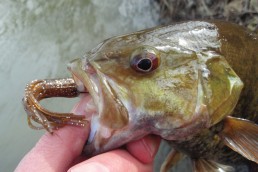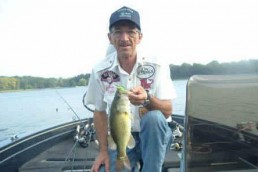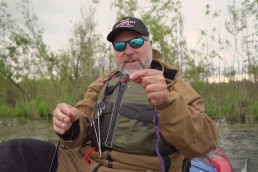Taking Bass on Terrific Tubes
SHARE THIS POST
by John Bennett
One of the most productive and versatile lures in an angler’s tackle bag is the tube. Until about 20 years ago, I was among those who had never heard of this terrific lure. It wasn’t until I began to compete in bass tournaments that I found out how effective they can be.
With a hollow body and a tail of tentacles, the tube at first glance seems to resemble nothing in the food chain. But when fished correctly, it mimics the actions of crawdads, shad, round gobies and other aquatic creatures. I discovered this the first time I dragged a tube across some of Lake Erie’s reefs and shoals. Rigged on a lead-head tube jig and hopped or dragged behind a drifting bass boat, it produced some very hefty, leaping smallmouths.
There is no doubt that color can make a difference in Lake Erie and other bodies of water. That day I was using a salt- impregnated dark-green tube with blue flecks that has proven its worth. Green pumpkin, avocado/gold flake, gobi, smoke and other colors have had their days in the sun and still produce limits of fish.
Are you enjoying this post?
You can be among the first to get the latest info on where to go, what to use and how to use it!
One of the greatest joys in my life is to hook a hefty smallmouth in one of the rivers of northwest Ohio. For the Auglaize, Blanchard or the Ottawa rivers, my usual rig consists of a 2 1/2- or 3-inch tube Texas rigged on a 4 or 6 Gamakatsu offset worm hook behind a 1/32-ounce slip sinker. The lighter the weight the better. In fact, if the current is not too strong on a given day, I’ll tie on a tube at various weights and allow them to tumble through the riffles and pools where hungry smallmouths are likely to be waiting.
My fishing partners and I always make our casts upstream since this is the direction the fish will be facing and waiting for morsels to be washed down by the flowing current. Any rocky points, submerged boulders, logs, laydowns or weed beds are likely targets and we’ll drag or hop our tubes past, below, or into all of them. Since a tube in the current mimics a dislodged, tumbling crawdad, we never overlook any shale bed, which is a natural place of refuge for these crustaceans. Good river colors have been a bluegill color, shad, smoke/blue glitter, green pumpkin and purple June bug.
The popularity in soft plastics definitely has benefited the largemouth fishermen who have added tubes to their arsenals. My success in lakes and farm ponds has increased exponentially since I began fishing them for bucketmouths. A Texas-rigged tube on an offset 1/0 or 2/0 worm hook below a 1/16- or a 1/8-ounce slip sinker that’s dragged or hopped very slowly across the bottom has saved more than one trip from becoming a complete washout.
Again, color does seem to make a difference with largemouths and smallmouths. Black neon, purple June bug, green pumpkin, watermelon seed and red shad, have all been producing some good catches. Often, the fish just want something different, and a small modification can make a difference. When the fish seem to be in a reluctant mood and are nipping at the tentacles of a tube, I’ve provoked hefty strikes by merely taking a pocketknife and reducing the length of the tail by about half an inch. Or, I just switch colors and again shorten the tail.
As long as they are made, I never will be without at least a few tube lures for bass fishing. MWO
MWO
SHARE THIS POST
Did you enjoy this post?
You can be among the first to get the latest info on where to go, what to use and how to use it!
Dave Mull
Dave Mull of Paw Paw, Mich. has spent his career communicating the outdoors experience and runs Inner Viking Media. He enjoys kayak fishing for anything that swims in the lakes and rivers of the Midwest and beyond, and even uses his MirroCraft, from time to time. Available for seminars.



